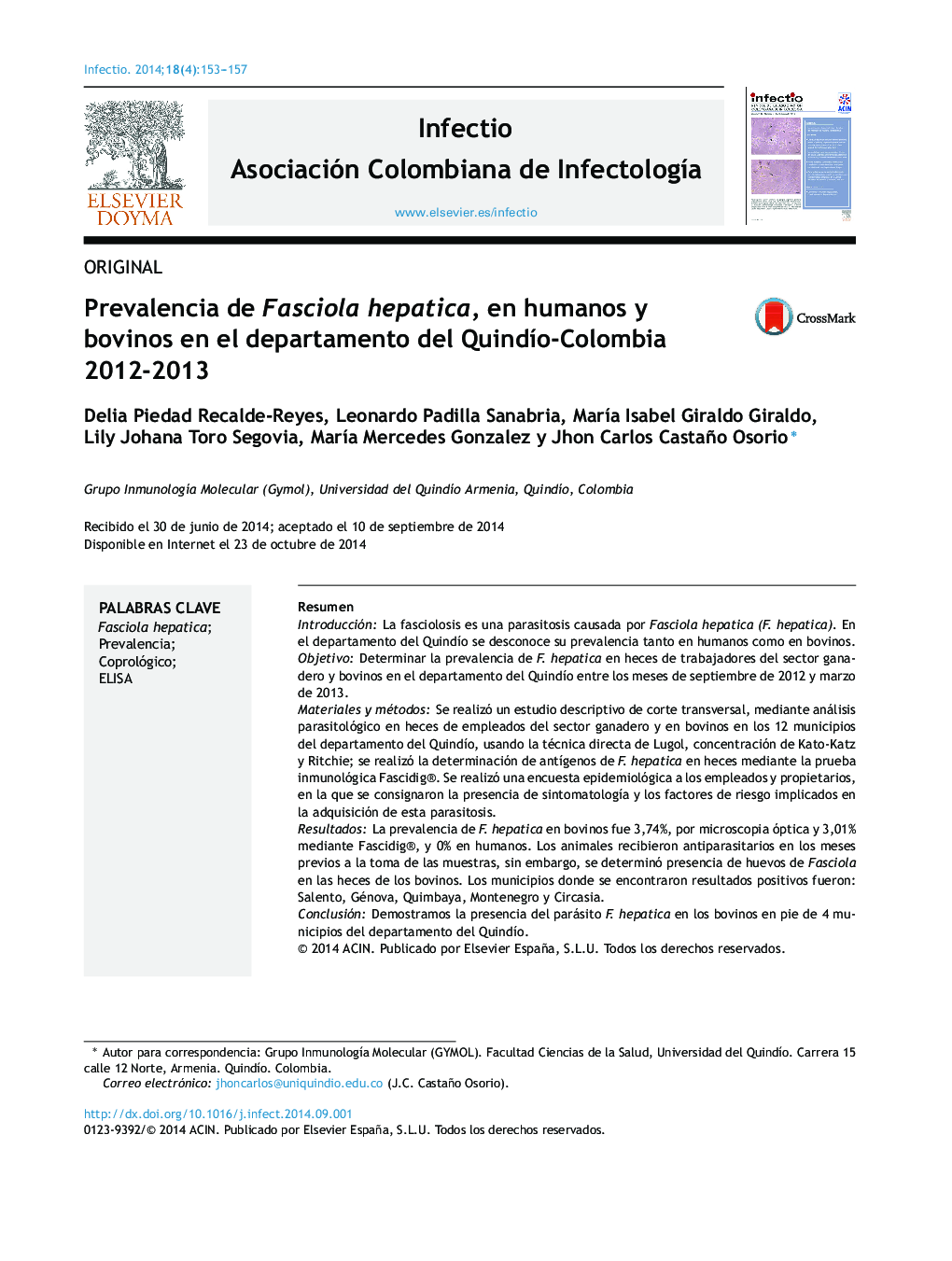| کد مقاله | کد نشریه | سال انتشار | مقاله انگلیسی | نسخه تمام متن |
|---|---|---|---|---|
| 3403705 | 1223085 | 2014 | 5 صفحه PDF | دانلود رایگان |

ResumenIntroducciónLa fasciolosis es una parasitosis causada por Fasciola hepatica (F. hepatica). En el departamento del Quindío se desconoce su prevalencia tanto en humanos como en bovinos.ObjetivoDeterminar la prevalencia de F. hepatica en heces de trabajadores del sector ganadero y bovinos en el departamento del Quindío entre los meses de septiembre de 2012 y marzo de 2013.Materiales y métodosSe realizó un estudio descriptivo de corte transversal, mediante análisis parasitológico en heces de empleados del sector ganadero y en bovinos en los 12 municipios del departamento del Quindío, usando la técnica directa de Lugol, concentración de Kato-Katz y Ritchie; se realizó la determinación de antígenos de F. hepatica en heces mediante la prueba inmunológica Fascidig®. Se realizó una encuesta epidemiológica a los empleados y propietarios, en la que se consignaron la presencia de sintomatología y los factores de riesgo implicados en la adquisición de esta parasitosis.ResultadosLa prevalencia de F. hepatica en bovinos fue 3,74%, por microscopia óptica y 3,01% mediante Fascidig®, y 0% en humanos. Los animales recibieron antiparasitarios en los meses previos a la toma de las muestras, sin embargo, se determinó presencia de huevos de Fasciola en las heces de los bovinos. Los municipios donde se encontraron resultados positivos fueron: Salento, Génova, Quimbaya, Montenegro y Circasia.ConclusiónDemostramos la presencia del parásito F. hepatica en los bovinos en pie de 4 municipios del departamento del Quindío.
IntroductionFascioliasis is a parasitic disease caused by Fasciola hepatica (F. hepatica). The prevalence of this infection in the region of Quindío in humans and in cattle is unknown.ObjectivesTo determine the prevalence of F. hepatica in feces of cattle workers and cattle in the region of Quindío from September 2012 to March 2013.Materials and methodsA descriptive, cross-sectional study was performed by parasitological analysis of feces of cattle workers and cattle in 12 municipalities of department of Quindío using the Lugol direct technique, Kato-Katz and Ritchie concentrations. The determination of Fasciola hepatic antigens in feces was performed by the Fascidig® immunological technique. In addition, an epidemiological survey concerning the symptomatology of the disease and the risk factors involved in the acquisition of this parasite was carried out.ResultsThe F. hepatica prevalence in cattle was 3,74%, by optical microscopy and 3,01% with Fascidig® and 0% in humans. The animals received antiparasitics in the months prior to the taking of samples; however the presence of F. hepatica eggs in cattle feces was determined. The cities where positive results were found include: Salento, Génova, Quimbaya, Montenegro y Circasia.ConclusionWe have demonstrated the presence of the parasite F. hepatica in cattle in 4 cities in the region of Quindío.
Journal: Infectio - Volume 18, Issue 4, October–December 2014, Pages 153–157